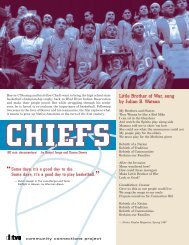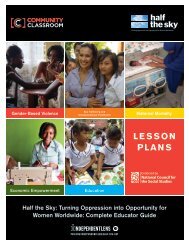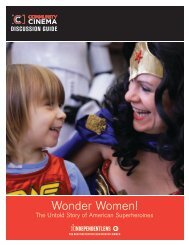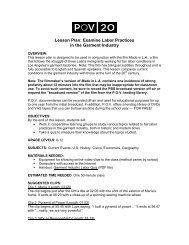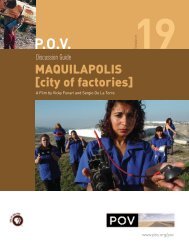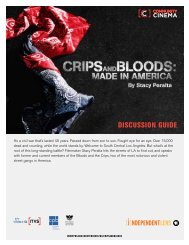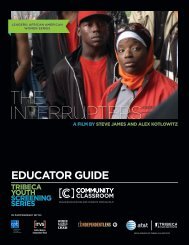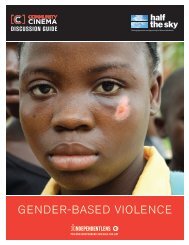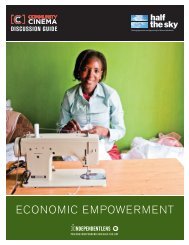THE VISUAL GRAMMAR OF FILM - FutureStates
THE VISUAL GRAMMAR OF FILM - FutureStates
THE VISUAL GRAMMAR OF FILM - FutureStates
Create successful ePaper yourself
Turn your PDF publications into a flip-book with our unique Google optimized e-Paper software.
CODE DE CONDUITE DE GOLF CANADAGolf Canada est fière de la qualité de ses joueurs et des clubs hôtes, ainsi que del'implication importante de la communauté à chaque tournoi. Pour faire de chaque tournoiune expérience agréable pour tous, les participants sont tenus de respecter le Code deconduite de Golf Canada.Le Code doit être respecté tout au long du tournoi.INFRACTIONS AU CODE DE CONDUITE SUR LE PARCOURS• Une conduite anti-sportive, y compris le langage offensant, les bâtons lancés, unmanque de respect à l’égard des bénévoles, des officiels ou des autres compétiteurs,et les dommages au parcours• La consommation d'alcool ou de drogues• L'inobservation du code vestimentaire lors des rondes de pratique ou de compétitionINFRACTIONS HORS LIEUX AU CODE DE CONDUITE• Tout vandalisme sur les lieux de l'hôtel du championnat, tout comportement violentenvers une famille hôte ou leur propriété.• Toute autre conduite indigne d'un participant de Golf CanadaCODE VESTIMENTAIRETenue réglementaire:• Casquette ou visière portée avec la visière devant; les hommes doivent enlever leurcasquette ou visière à l'intérieur des installations hôtes.• Polo de golf avec le pan de chemise rentré à la taille.Tenue prohibée :• Débardeur, t-shirt.• Shorts en denim, shorts courts, shorts sans ourlet, shorts d'exercice, jeans.• Shorts tombant plus bas que les genoux, ou dont les bords sont roulés.• Souliers avec crampons en métal ou crampons traditionnels.Une mise vestimentaire appropriée est de rigueur en tout temps au club hôte. Tout cas detenue inappropriée sera examiné par le comité de tournoi. Lorsque le code d'un club hôterelatif à la tenue vestimentaire s'avère plus sévère que le code de Golf Canada, le code duclub prévaut. Tout joueur qui ne respecte pas le code vestimentaire n'aura pas le droit dejouer ou, si le jeu est déjà commencé, le joueur devra cesser immédiatement de jouer.MESURES DISCIPLINAIRES• L'inscription du joueur peut être révoquée à tout moment (y compris durant lechampionnat) par la Golf Canada. Une conduite indigne peut entraîner la révocation deson inscription.• Toute infraction au Code de conduite sera signalée par avis écrit au participant.
The Idea: The idea was born eight years ago. I was backpacking around South East Asia andlonged to go around the world. In 2008, I decided to go ahead and do it. My budget was 20,000pounds. I travel alone, sometimes accompanied by cameramen from the television companiesfor short distances. I plan everything on my own and post a diary on my blog.The Challenge: Expedition expenses are met from personal funds and contributions fromNational Geographic, Lonely Planet and BBC.I observe certain Guinness Book of Records rules like not using air transport or transport of myown. So far I have used a strange mix of transport, from cargo ships to private yachts andfishing vessels. I manage to gather support by talking to people and explaining what I’m doingand they have been helpful.In a new country: I spend some time at each place and usually have to wait for visas othertravel documents. I travel fast and travel light (a sleeping bag, a week’s change of clothes, acamcorder and medicines, all in a backpack). I travel with local people and often stay with them.This helps me get a better feel of the place. It is much better than flying into an airport and thenflying out again.There have been some bad experiences but largely, it has been a wonderful journey amongfriendly people.Future Plans: I plan to write a book once I end this expedition in New Zealand.
COMMUNITY CLASSROOM: <strong>THE</strong> <strong>VISUAL</strong> <strong>GRAMMAR</strong> <strong>OF</strong> <strong>FILM</strong>Media Habits SurveyUse the following scale to identify how often you partipate in the following:Often Sometimes Rarely Never4 3 2 1_______Play videogames_______Play interactive videogames with other people online, such as World of Warcraft or similarrole playing games_______Use Facebook, MySpace, Twitter, or similar social networking sites_______Keep a blog_______Share music online_______Use the internet for research_______Watch TV shows and movies online on sites such as Hulu_______Watch videos on YouTube or similar video sharing sites_______Create and share your own videos_______Look online for current news and/or sports information_______Send e-mails_______Send textsWrite for a few minutes about your own media viewing and creating habits. How are you similar or differentfrom your parents/guardians in your use of media? How has your use of media changed as you’ve grownolder?FUTURESTATES.TV PAGE 5
COMMUNITY CLASSROOM: <strong>THE</strong> <strong>VISUAL</strong> <strong>GRAMMAR</strong> <strong>OF</strong> <strong>FILM</strong>Film TerminologyShots and FramingShot: A single piece of film uninterrupted by cuts.Establishing Shot: Often a long shot or a series of shots that sets the scene. It is used to establish settingand to show transitions between locations.Long Shot (LS): A shot from some distance. If filming a person, the full body is shown. It may show theisolation or vulnerability of the character (also called a Full Shot).Medium Shot (MS): The most common shot. The camera seems to be a medium distance from the objectbeing filmed. A medium shot shows the person from the waist up. The effect is to ground the story.Close Up (CU): The image being shot takes up at least 80 percent of the frame.Extreme Close Up: The image being shot is a part of a whole, such as an eye or a hand.Two Shot: A scene between two people shot exclusively from an angle that includes both characters more orless equally. It is used in love scenes, where the interaction between the two characters is important.Camera AnglesEye Level: A shot taken from a normal height; that is, the character’s eye level. Ninety to ninety-five percent ofall shots are taken at eye level because it is the most natural angle.High Angle: The camera is above the subject. This usually has the effect of making the subject look smallerthan normal, giving him or her the appearance of being weak, powerless, and trapped.Low Angle: The camera films the subject from below. This usually has the effect of making the subject looklarger than normal, and therefore strong, powerful, and threatening.Camera MovementsPan: A stationary camera moves from side to side on a horizontal axis.Tilt: A stationary camera moves up or down along a vertical axisZoom: A stationary camera lens is adjusted to make an object seem to move closer to or further awayfrom the camera. With this technique, moving toward a character often preceeds a personal or revealingmovement, while moving away distances or separates the audience from the character.Dolly/Tracking: The camera is on a track that allows it to move with the action. The term also refers to anycamera mounted on a car, truck, or helicopter.Boom/Crane: The camera is on a crane over the action. This is used to create overhead shots.FUTURESTATES.TV PAGE 6
COMMUNITY CLASSROOM: <strong>THE</strong> <strong>VISUAL</strong> <strong>GRAMMAR</strong> <strong>OF</strong> <strong>FILM</strong>Film Terminology (cont.)LightingHigh Key: The scene is flooded with light, creating a bright and open-looking scene.Low Key: The scene is flooded with shadows and darkness, creating suspense or suspicion.Bottom or Side Lighting: Direct lighting from below or the side, which often makes the subject appeardangerous or evil.Front or Back Lighting: Soft lighting on the actor’s face or from behind gives the appearance of innocence orgoodness, or a halo effect.Editing TechniquesCut: The most common editing technique. Two pieces of film are spliced together so that the film “cuts” fromone image to another.Fade: Can be to or from black or white. A fade can begin in darkness and gradually assume full brightness(fade-in) or the image may gradually get darker (fade-out). A fade often implies that time has passed or maysignify the end of a scene.Dissolve: A kind of fade in which one image is slowly replaced by another. It can create a connectionbetween images.Wipe: A new image wipes off the previous image. A wipe is more fluid than a cut and quicker than adissolve.Flashback: Cut or dissolve to action that happened in the past.Shot-Reverse-Shot: A shot of one subject, then another, then back to the first. It is often used forconversation or reaction shots.Cross Cutting: Cuts between actions that are happening simultaneously. This technique is also called parallelediting. It can create tension or suspense and can form a connection between scenes.Eye-Line Match: Cut to an object, then to a person. This technique shows what a person seems to belooking at and can reveal a character’s thoughts.SoundDiegetic: Sound that could logically be heard by the characters in the film.Non-Diegetic: Sound that cannot be heard by the characters but is designed for audience reaction only. Anexample might be ominous music for foreshadowing.FUTURESTATES.TV PAGE 7
COMMUNITY CLASSROOM: <strong>THE</strong> <strong>VISUAL</strong> <strong>GRAMMAR</strong> <strong>OF</strong> <strong>FILM</strong>Film Viewing Note Taking Form:Cinematic ElementsTitle of Film:___________________________Director: ______________________________Shot Types Angles Camera MovementLigthing Sound EditingGeneral ResponseFUTURESTATES.TV PAGE 8
COMMUNITY CLASSROOM: <strong>THE</strong> <strong>VISUAL</strong> <strong>GRAMMAR</strong> <strong>OF</strong> <strong>FILM</strong>Film Viewing Note Taking Form:Theatrical ElementsTitle of Film:___________________________Names of Characters: _____________________________________Costumes/Makeup Props/Sets Acting ChoicesTitle of Film:___________________________Names of Characters: _____________________________________Costumes/Makeup Props/Sets Acting ChoicesTitle of Film:___________________________Names of Characters: _____________________________________Costumes/Makeup Props/Sets Acting ChoicesFUTURESTATES.TV PAGE 9
COMMUNITY CLASSROOM: <strong>THE</strong> <strong>VISUAL</strong> <strong>GRAMMAR</strong> <strong>OF</strong> <strong>FILM</strong>Film Viewing Note Taking Form:Theatrical and Cinematic ElementsTitle of Film:________________________________Director: _____________________________________CINEMATICShot type, angle, lighting, sound, etc.<strong>THE</strong>ATRICALCostumes, props, sets, acting, etc.General ResponseFUTURESTATES.TV PAGE 10
COMMUNITY CLASSROOM: <strong>THE</strong> <strong>VISUAL</strong> <strong>GRAMMAR</strong> <strong>OF</strong> <strong>FILM</strong>LESSON PLAN CREDITSCURRICULA WRITERJohn GoldenJohn Golden is currently a curriculum specialist for highschool Language Arts in Portland, Oregon. He is the authorof Reading in the Dark: Using Film as a Tool in the EnglishClassroom (NCTE, 2001) and Reading in the Reel World:Teaching Documentaries and Other Nonfiction Texts (NCTE,2006). John has delivered presentations and led workshopsaround the country in order to help teachers use film activelyin the classroom as a way for students to improve theirreading, analytical and critical thinking skills.CONTENT MANAGERAnnelise WunderlichITVSCURRICULUM ADVISORSJenny BradburyPBS TeachersKara ClaytonNational Association for Media Literacy EducationJoseph FathereeNational State Teachers of the YearAbout FUTURESTATES:Imagining tomorrow’s America today, FUTURESTATES is aseries of independent mini-features — short narrative filmscreated by experienced filmmakers and emerging talentstransforming today’s complex social issues into visions aboutwhat life in America will be like in decades to come. The firstseason of FUTURESTATES debuted in March 2010, and isavailable online at futurestates.tv.About ITVS:The Independent Television Service (ITVS) funds andpresents award-winning documentaries and dramas on publictelevision, innovative new media projects on the Web and theEmmy Award-winning weekly series Independent Lens onTuesday nights at 10 PM on PBS. ITVS is a miracle of publicpolicy created by media activists, citizens and politiciansseeking to foster plurality and diversity in public television.ITVS was established by a historic mandate of Congressto champion independently produced programs that takecreative risks, spark public dialogue and serve underservedaudiences. Since its inception in 1991, ITVS programs haverevitalized the relationship between the public and publictelevision, bringing TV audiences face-to-face with the livesand concerns of their fellow Americans. More informationabout ITVS can be obtained by visiting itvs.org. ITVS isfunded by the Corporation for Public Broadcasting, a privatecorporation funded by the American people.John GoldenNational Council of Teachers of EnglishMatthew LappéAlliance for Climate EducationLESSON PLAN DESIGN AND LAYOUTWilson LingITVSEDITORIAL REVIEWLuke SykoraITVSFUTURESTATES.TV PAGE 11




